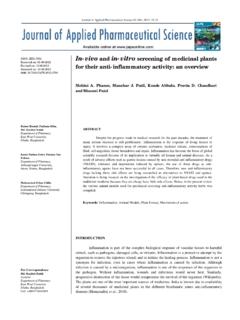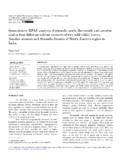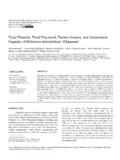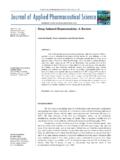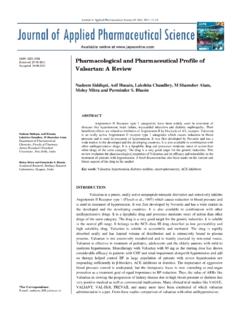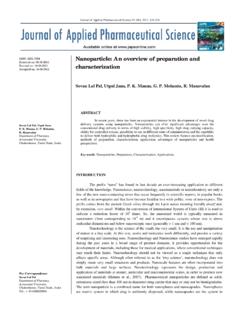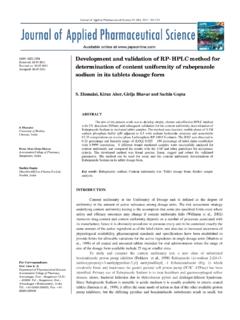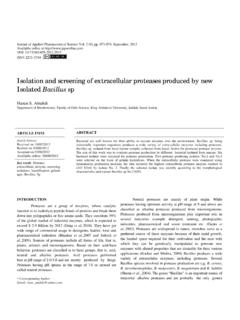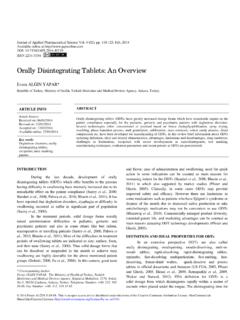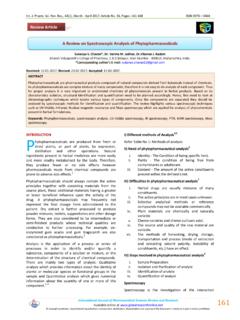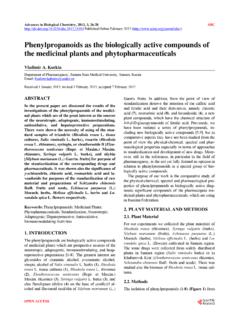Transcription of Future Trends in Standardization of Herbal Drugs
1 Journal of Applied Pharmaceutical Science 02 (06); 2012: 38-44 ISSN: 2231-3354 Received on: 24-04-2012 Revised on: 06-05-2012 Accepted on: 21-05-2012 DOI: Pravin H. Nikam, Joseph Kareparamban, Aruna Jadhav and Vilasrao Kadam Department of Quality Assurance, Bharati Vidyapeeth s College of Pharmacy, Sector-8, , Belapur, Navi Mumbai-400614, Maharashtra, India. For Correspondence Pravin H. Nikam, Bharati Vidyapeeth s College of Pharmacy, Sector-8, , Belapur, Navi Mumbai- 400614, Maharashtra, India Tel: 91-22-27571122, Fax: 91-22-17578142, Mobile: 91-9892272652 Future Trends in Standardization of Herbal Drugs Pravin H. Nikam, Joseph Kareparamban, Aruna Jadhav and Vilasrao Kadam ABSTRACT In recent years more people throughout world are turning to use medicinal plant products in healthcare system.
2 World wide need of alternative medicine has resulted in growth of natural product markets and interest in traditional systems of medicine. Herbal drug technology is used for converting botanicals materials into medicines, where Standardization and quality control with proper integration of modern scientific techniques and traditional knowledge is important. In order to prove constant composition of Herbal preparations, adequate analytical methods the have to be applied such as photometric analysis, thin layer chromatography [TLC], high performance liquid chromatography [HPLC], and gas chromatography [GC], DNA Fingerprinting. Keywords: Standardization , Chromatographic Fingerprinting, DNA Fingerprinting. INTRODUCTION Herbal Drugs have been used since ancient times as medicines for the treatment of a range of diseases. Medicinal plants have played a key role in world health.
3 In spite of the great advances observed in modern medicine in recent decades, plants still make an important contribution to health care (Calixto et al., 2000). Natural products have been our single most successful source of medicines. Each plant is like factory capable of synthesizing unlimited number of highly complex and unusual chemical substances whose structures could otherwise escape the imagination forever (Kinghorn, 2002). There are at least 120 distinct chemical substances derived from plants that are considered as important Drugs currently in use in the world, while several other Drugs are simple synthetic modifications of the natural products (Farooqi, 2001). WHO has provided some terms related to Herbal Drugs , according to their definitions. Herbal medicines include herbs, Herbal materials, Herbal preparations and finished Herbal products. In some countries Herbal medicines may contain, by tradition, natural organic or inorganic active ingredients that are not of plant origin ( animal and mineral materials).
4 Journal of Applied Pharmaceutical Science 02 (06); 2012: 38-44 Herbs include crude plant material, such as leaves, flowers, fruit, seeds, stems, wood, bark, roots, rhizomes or other plant parts, which may be entire, fragmented or powdered. Herbal materials include, in addition to herbs, fresh juices, gums, fixed oils, essential oils, resins and dry powders of herbs. In some countries, these materials may be processed by various local procedures, such as steaming, roasting or stir-baking with honey, alcoholic beverages or other materials. Herbal preparations are the basis for finished Herbal products and may include comminuted or powdered Herbal materials, or extracts, tinctures and fatty oils of Herbal materials. They are produced by extraction, fractionation, purification, concentration, or other physical or biological processes.
5 They also include preparations made by steeping or heating Herbal materials in alcoholic beverages and/or honey, or in other materials. Finished Herbal products consist of Herbal preparations made from one or more herbs. If more than one herb is used, the term mixture Herbal product can also be used. Finished Herbal products and mixture Herbal products may contain excipients in addition to the active ingredients. However, finished products or mixture Herbal products to which chemically defined active substances have been added, including synthetic compounds and/or isolated constituents from Herbal materials, are not considered to be Herbal (WHO guideline, 2000). So that it is necessary to maintain reproducible efficacy and safety of phytopharmaceutical therefore if phytopharmaceuticals have to regarded as rational drug they should be standardized and pharmaceutical quality must be approved (Bauer et al.)
6 , 1993). World Health Organization (WHO) stresses the importance of the qualitative and quantitative methods for characterizing the samples, quantification of the biomarkers and/ or chemical markers and the fingerprint profiles. If a principle active component is known, it is most logical to quantitate this compound. Where active ingredients contributing to therapeutic efficacy are known botanical preparations should be standardized to these compounds. Where the active ingredients are not yet known a marker substance which should be specific for the botanical could be chosen for analytical purpose (Dixit et al., 2008). Standardization As commercialization of the Herbal medicine has happened, assurance of safety, quality and efficacy of medicinal plants and Herbal products has become an important issue.
7 The Herbal raw material is prone to a lot of variation due to several factors, the important ones being the identity of the plants and seasonal variation (which has a bearing on the time of collection), the ecotypic, genotypic and chemotypic variations, drying and storage conditions and the presence of xenobiotic (Dixit et al., 2008). Standardization as defined by American Herbal Product association: Standardization refers to the body of information and control necessary to product material of reasonable consistency. This achieved through minimizing the inherent variation of natural product composition through quality assurance practices applied to agricultural and manufacturing processes (Waldesch et al., 2003). Methods of Standardization should take into consideration all aspects that contribute to the quality of the Herbal Drugs , namely correct identity of the sample, organoleptic evaluation, pharmacognostic evaluation, volatile matter, quantitative evaluation (ash values, extractive values), phytochemical evaluation, test for the presence of xenobiotics, microbial load testing, toxicity testing, and biological activity.
8 Of these, the phytochemical profile is of special significance since it has a direct bearing on the activity of the Herbal Drugs . The fingerprint profiles serve as guideline to the phytochemical profile of the drug in ensuring the quality, while quantification of the marker compound/s would serve as an additional parameter in assessing the quality of the sample. Phytochemical Standardization encompasses all possible information generated with regard to the chemical constituents present in an Herbal drug . Hence, the phytochemical evaluation for Standardization purpose includes the following: 1. Preliminary testing for the presence of different chemical groups. 2. Quantification of chemical groups of interest ( , total alkaloids, total phenolics, total triterpenic acids, total tannins). Establishment of fingerprint profiles. 3.
9 Multiple marker-based fingerprint profiles. 4. Quantification of important chemical constituents (Calixto et al., 2000). METHODS OF Standardization Phytotherapeutic agents are normally marketed as standardized preparations in the form of liquid, solid (powdered extract), or viscous preparations. They are prepared by maceration, percolation or distillation (volatile oils). Ethanol, water, or mixtures of ethanol and water are used for the production of fluid extracts. Solid or powered extracts are prepared by evaporation of the solvents used in the process of extraction of the raw material. Some phytotherapeutic agents are greatly concentrated in order to improve their therapeutic efficacy (Schulz et al., 1996). Approach towards Standardization of Herbal drug Conventional methods for Standardization of Herbal formulation Standardization of Herbal raw Drugs include passport data of raw plant Drugs , botanical authentification, microscopic & molecular examination, identification of chemical composition by various chromatographic techniques and biological activity of the whole plant (Patel et al.)
10 , 2006). Macroscopic and microscopic evaluation and chemical profiling of the Herbal materials for quality control and Standardization have been in use for Standardization . Macroscopic identity of medicinal plant materials is based on sensory evaluation parameters like shape, size, colour, texture, odour and taste while microscopy involves comparative microscopic inspection of powdered Herbal drug . Further, advances in microscope technology have increased the accuracy and Journal of Applied Pharmaceutical Science 02 (06); 2012: 38-44 capabilities of microscopy as a mean of Herbal crude material identification due to the implication of light and scanning electron microscopes (SEM) in Herbal drug Standardization (Bhutani, 2003). Standardization of Herbal formulation Standardization of Herbal formulation requires implementation of Good Manufacturing Practices (GMP) ( WHO guideline, 1996) In addition, study of various parameters such as pharmacodynamics, pharmacokinetics, dosage, stability, self-life, toxicity evaluation, chemical profiling of the Herbal formulations is considered essential (Mosihuzzaman et al.
